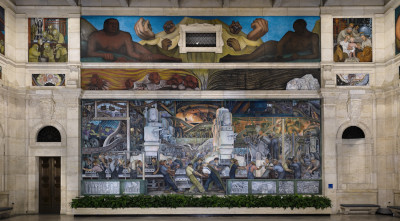Diego Rivera's Detroit Industry Murals were amongst his finest achievements, and helped to establish him as one of the most famous muralists of all time. These sprawling creations can be discussed individually, such is their size and detail and here we specifically examine the work that adorned the North Wall.
The artist worked on this fresco between the years of 1932-1933, at which point he would have been in his mid to late forties and approaching his artistic peak. The overall display features several different paintings which are placed around the architecture of the wall, meaning Rivera would have had to plan each design around the technicalities of the building. For example, to the left and right hand sides are two narrow sections which are separated from the main area by two columns. The main panel is then cut into three sections, with some small stone features running across in between. To the bottom left we have a doorway, with arch and sculpture just above. Rivera then adds two small artworks above that, and does the same on the other side. These artworks are around two metres in width, where as those in the centre are all thirteen metres wide. Rivera would plan his designs to be consistent along a single theme, but that each individual piece could stand on its own as a seperate piece.
The relatively small size of the side paintings means that they are more of a supporting element to the main panels, and even within that, it is the lower panel which focuses our eye the most. This captures the essence of the overall project, focusing on the industry of Detroit. We find normal workers going about their daily tasks, in just the same way that Rivera would earlier capture the peasants and working poor of his native Mexico. He would travel regularly in order to discover new artistic methods, and famously produced a body of Cubist art in the 1910s whilst living in Europe. The US brought him many opportunities from a commercial sense, with his Detroit North and South Wall murals being amongst the most memorable of all. Despite his switch to a new nation, he continued his love for mural art, as well as continuing to focus on the lives of the ordinary, with whom he shared a strong connection and empathy.
The murals can be found within the Detroit Institute of Arts, US, and this institution also holds a number of smaller paintings and drawings from Rivera's career. Work was added to the North, South, East and West walls, but the main interest can be found in the North and South regions of the building. We find labourers busy at work within Ford Motor Company's River Rouge Plant and this theme is entirely representative of Detroit as a city at that time, where automotive industry was booming. It is therefore a celebration of the hard working nature of local people, as well as the innovation which helped the city to dominate within this particular industry for a good number of decades. Things have changed somewhat today and so murals such as this are crucial in reminding residents as to how the city's wealth was intially built. The North Wall remains one of the biggest attractions to be found in the Detroit Institute of Arts, despite having such a strong and diverse selection of art.




